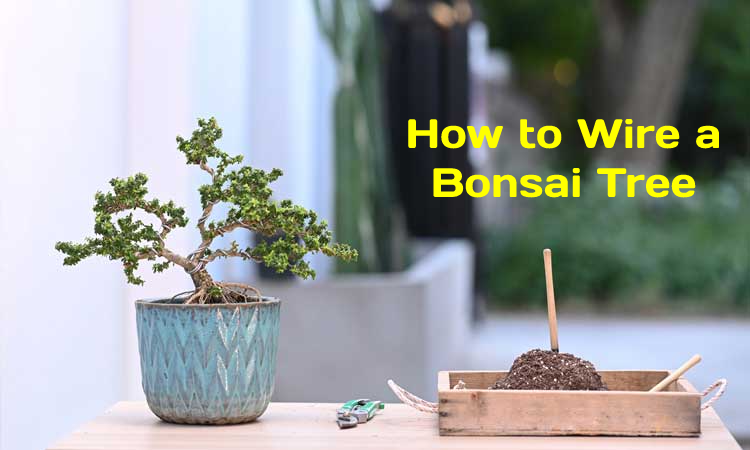Bonsai wiring can be simple or complex, easy or difficult, wild or curated. Bonsai, like life, is a journey to be enjoyed step by step. Bonsai wire teaches us that even the most aged little tree can be beautiful. Are you interested in learning more about bonsai wiring and shaping?
Wrapping wire around the trunk and branches allows bonsai tree styling, and wires can achieve more intricate designs.
But the ultimate question is, when should you apply the wire to your Bonsai? Does it need to be wired every time, or is there a specific time to do so?
When should I apply wire?
You can place bonsai wire on your tree any time during the year. After a few months, the wire’s branches will fall in their new places. Due to the lack of leaves, bonsai trees are significantly easier to wire in the late winter.
If you’re wiring in the early spring, keep an eye on your branches because the spring and summer growing seasons can cause them to grow faster.
You can wire the bonsai tree and repeat this technique multiple times until the desired final shape is achieved. Wires should never be allowed to burrow into the bark of your Bonsai as it will leave scars or wounds. Because the tree’s branches thicken with age, cut the wire before it “digs” into the bark.
It is a slow and lengthy process; let’s dive deep into it to find why it is required to wire bonsai tree?
Outdoor bonsai trees for sale offer a wonderful way to add beauty and nature to your outdoor space. With a wide variety of species and sizes available, there’s an outdoor bonsai tree to suit any taste and space. These miniature trees require special care and attention to thrive, so be sure to research the specific needs of your chosen tree before purchasing. Shop around to find the perfect outdoor bonsai tree for you.
Why do you need to wire Bonsai?
Bonsai Wire is an essential technique for shaping bonsai trees into desired designs. We wrap the branches of our Bonsai with a special wire to direct their growth in a specific direction.
Wire Bonsai tree as it can help your tree in many ways, like:
- It’s the most common method for turning your wire bonsai tree into a work of art.
- Wiring’s primary aim is to alter the overall shape of the Bonsai you’re growing.
- You can change the shape of the trunk, branches, and new shoots due to wiring to create it according to your dream tree.
- Wiring is a technique used in Bonsai to change the position of branches without having to prune them.
The trunk and tree branches are wired upwards and outwards during the wiring procedure. The pressured areas beneath the bark leave microscopic fractures and wounds. The injured layers of the trunk heal slowly and progressively. The branches adapt to their new placements and expand per your instructions. It is because your Bonsai’s vascular tissues thicken over the growing season, helping the tree to maintain its intended shape.
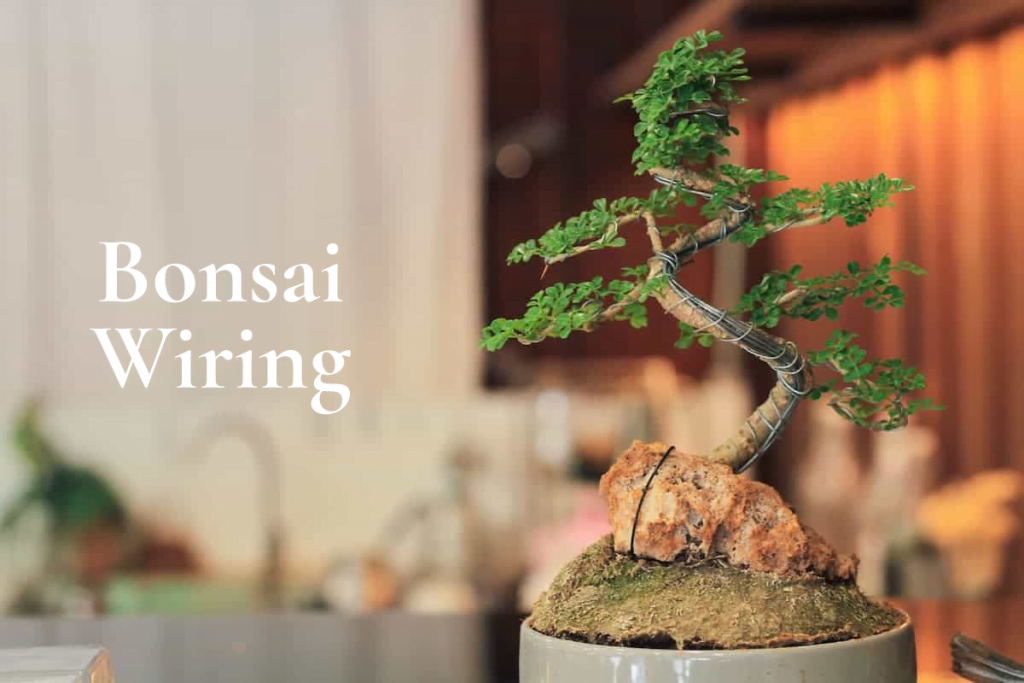
The Bonsai Wire is used in the same way braces are used on a child’s teeth. It’s a one-time use shaping device meant to be discarded once it’s done its job.
The goal of the wire bonsai tree is to bend tree trunks and branches. The wire is the easiest and quickest approach to get the job done in most cases.
Wiring can be overwhelming for beginners, but control and preciseness emerge with practice and patience. Wiring is one of the calmest and most fun aspects of bonsai construction. Many people are confused about which bonsai wire to use. Let us break down the types of wires for you.
Wire Types to use on Bonsai
You can use any form of wire to shape a bonsai in general. The goal is to bend the branch, and all tactics are acceptable to attain that goal. On the other hand, copper and aluminum wire have become the industry standard.
Bonsai Wire is available in varieties. They might be as thick as a pencil or as thin as a needle in thickness. The most crucial guideline to remember when it comes to wiring is that you should only have a healthy wire bonsai tree for training.
When used in the proper gauges, both types have enough holding power and are malleable and easy to apply to the tree. Copper wire bonsai tree acquires a black patina, and bonsai aluminum wire has a brown anodized coating that makes it darker and less glossy.
Depending on the trees and if you are a beginner or an experienced keeper, you will need to use different wires (copper wire bonsai tree is harder to work with). Copper and aluminum both have benefits and drawbacks when it comes to utilization. Let’s cover each one by one.
Annealed Copper Wire
The copper wire bonsai tree is frequently used in the procedure. It should be annealed before use to make it more flexible for wiring by heating the copper to a temperature that softens the wire. Annealing the copper wire bonsai tree makes it easier to wrap around the branch, but it also restores the wire’s original hardness and strength, which will help it hold the branch in place.
Note for newbies in the annealing process: Only heat the wire until it glows red before removing it from the fire and allowing it to cool slowly. The bonsai wire will crystallize and crumble if it is over-heated.
You can also burn it by covering it in newspaper and wrapping it in it. The heat from the burning newspaper is sufficient to soften it.
Pros of Annealed Copper Wire
The advantages of shaping with copper wire bonsai tree include:
- It is more durable and more powerful than aluminum wire.
- Bonsai wire can also be trained with single-core PVC-coated copper cable. You should not remove the PVC covering on the branches because it protects them from irreversible scarring.
- It is suitable for bonsai-like coniferous as there are pretty strong.
Cons of Annealed Copper Wire
The disadvantages of utilizing copper wire Bonsai tree are as follows:
- It’s more challenging to work with and more difficult to shape. As a result, it may be a less appealing alternative for beginners.
- Its rough surface can slash through soft tree branches. It can, however, be used on tougher trunks, such as conifers.
- Due to the brilliant colors, single-core PVC coated wire is apparent on Bonsai. Most people simply use it to shape their Bonsai, not depict them.
Anodized Aluminum Wire
Anodized Aluminum Bonsai Wire is the second and most preferred option. It is beginner-friendly and relatively easy to work with. Aluminum is a far more flexible metal than copper. Softer aluminum is less likely to harm these more delicate trees.
You can find them in various thicknesses ranging from 1 to 8 millimeters. However, you do not need to buy wire in all of these sizes. We recommend starting with bonsai wire sizes of 1mm, 1.5mm, 2.5mm, and 4mm for most trees.
They come in a variety of colors. Silver, black, or copper, for example. These bonsai wires have the same function and qualities, despite their color differences.
Just like a coin has two sides, the Anodized Aluminum Wire bonsai tree has its own pros and cons. Let’s hop onto the same.
Pros of Anodized Aluminum Wire
The advantages of anodized aluminum wire bonsai tree:
- It’s more flexible and relatively easier to work with.
- It’s perfect for deciduous trees like maples, elms, and olives because of its smooth surface.
- It doesn’t look too unpleasant when wrapped around branches because of its dark tint. It blends in with the tree’s bark in terms of aesthetics.
- It is unaffected by water, soil, or fertilizer.
- It can be uncoiled from the branch, straightened, and reused on another tree in the future.
Cons of Anodized Aluminum Wire
The disadvantages of using anodized aluminum wire are as follows:
- When compared to the regular copper wire bonsai tree, it is a little more expensive.
- It is not as durable as copper wire.
Bonsai Tree Wiring Techniques
Wiring small trees might be complex because of their fragility. The wire is often left on a tree for as long as it takes to ramify and stay in place. The trunk and principal branches must be wired to achieve the desired shape. In comparison to the main branches, minor ones are thinner. They should also be wired to give your Bonsai tree a more stylish appearance.
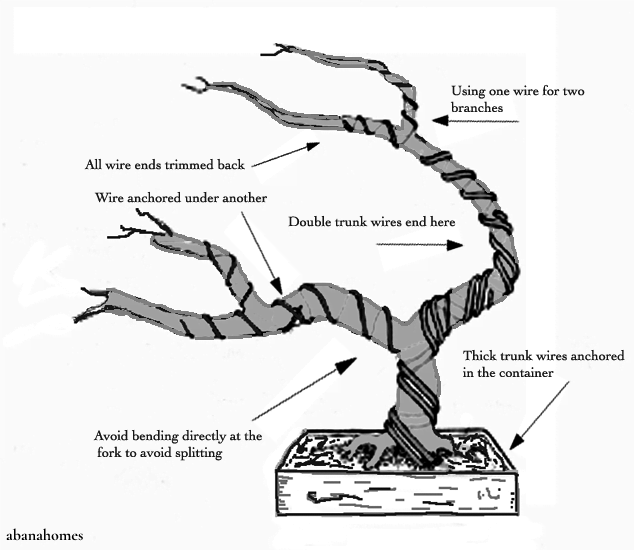
Always start with the thickest gauge wire and work your way down to thinner and thinner gauge wire. Crossing wires, on the other hand, is not a good idea. It will cause damage to the tree, and wire markings are unsightly.
The two types of wiring are used for wiring a bonsai
- Single Wiring
- Double Wiring
Let’s understand them in detail.
Single Wiring
- Similar to the double wiring approach, cut the appropriate length of wire. Wrap it twice around the trunk or major branches to begin. Maintain a 45-degree angle for better results.
- If too many cables are wrapped in the same trunk area, ensure they are appropriately arranged in a line. Simply put, if there are several coils on the tree, they should all be coiled in the same direction.
- Wire bonsai tree in the same way.
- You can now bend and move the branches once you’ve wired the entire tree. With your fingertips, grasp the branch’s exterior. Bend the branch of the Bonsai from the inside of the curve using your thumbs.
You can now angle and reposition the branches once you’ve wired the entire tree. With your fingertips, grasp the branch’s exterior. Bend the branch from the inside using your thumbs.
Because you’re applying stress on the branch’s exterior, the chance of branch fracture is reduced. Once the branch has been repositioned, stop bending. To give the tree a more aesthetic, natural, and aged appearance, the straight sections of the branch should be slightly bent.
Next, you must place the newly wired tree in a shady location for 2 to 4 days. Fertilize the wire bonsai tree in the usual manner. During the growing season, keep a watch on the bonsai wire. The wire may cut into the bark if you leave your tree unsupervised. As a result, remove it promptly and avoid attempting to unwind the wire, as this may cause harm to the bark.
Double Wiring
- Choose two prominent branches that have the same thickness and are close to each other.
- To secure them around the trunk, use a single piece of bonsai wire. Start coiling the wire around it and passing it beneath that branch if you need to bend it upwards. It protects the branch by supporting it and preventing it from breaking.
- Twist the bonsai wire down from above to connect to the trunk to bend a branch upwards.
- From the base to the tip, evenly coil both branches. While wrapping the wire bonsai tree around the branches, keep it at a 45-degree angle. The tree will be able to grow thicker while maintaining its new shape.
- Wrap the bonsai wire around the trunk two times if possible. Later on, bending the branches will prevent the wire from moving.
- After you’ve wired all of the appropriate pairs of branches, wrap the wire around the remaining using the single-wiring technique.
Bonsai Wiring – General Guidelines & Tips
- Always start with the thickest branches and the heaviest wire, as this is a solid rule of thumb. Work your way down to thinner branches and wire bonsai tree. It will make keeping the wire arrangement neat and orderly a lot easier.
- Use a thick bonsai wire for thick branches. A single wire cannot normally bend a thick trunk.
- Try to use the same bonsai wire to wire the two branches of the same thickness. The paired and wired branches are then fastened around the trunk to keep them in place.
- When at all possible, avoid crossing wires. You should follow previous strands up the trunk and out the next branch. As a result, the holding strength will be increased, and the appearance will be much more professional.
- The bonsai wire should be close against the bark, with no gaps or voids, but not so tight that it cuts into and harms the bark. Between the wire and the bark, there should be no daylight. The possibility of cracks or stress fractures in the branch increases if the wire is applied loosely.
- The wire bonsai tree should be coiled at a 45-degree angle perpendicular to the branch or trunk and tucked in tight against it. The best holding power appears to be at an angle of roughly 45 degrees.
- When applying bonsai wire, always use your opposite hand’s thumb and forefinger to support the branch being wired. Bring it to the wire bonsai tree and wrap it around the branch, rotating it slightly. It will sit against it due to this rotation. This strategy ensures that the branch is always well supported and avoids unwanted breaks.
- You should place the bonsai wire outside any anticipated curves or bends. The tree’s wood is crushed inside the curve and stretched on the outer area while bending a branch. Wire placed along the outside of the curve gives essential support where it’s required the most.
- If you need to replant your wire Bonsai tree, make sure you first wire it. It will be tough to wire after transplanting, and it will place a strain on your Bonsai’s root system. During the growing season, avoid wiring your Bonsai because your tree is actively expanding. It may cause scarring from the wire cutting into your bonsai tree.
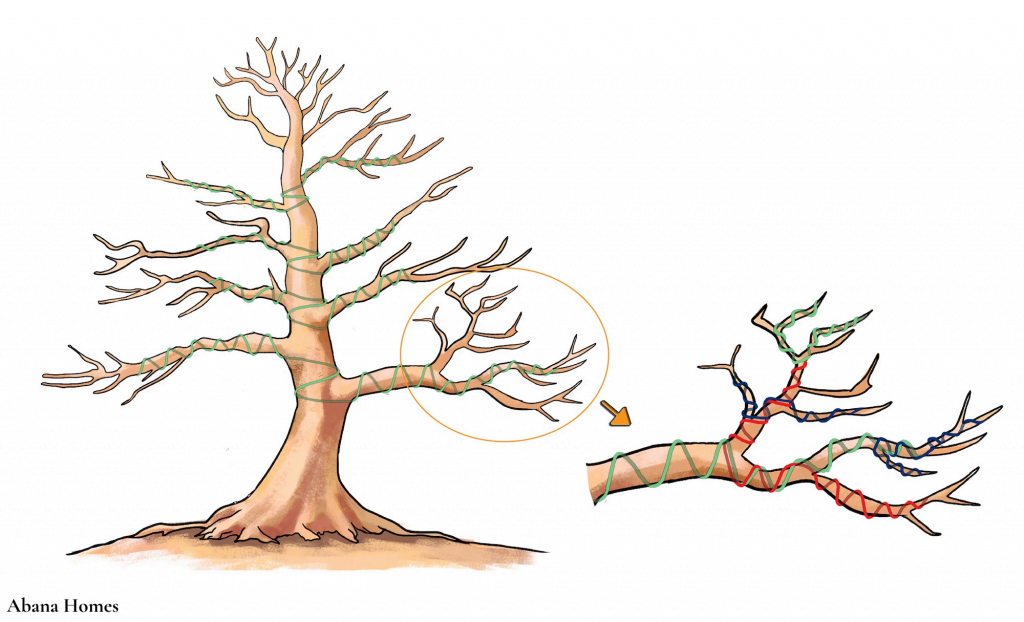
It is best to develop a technique to wire bonsai trees with which you are personally comfortable. Be neat and organized, and attempt to use the least amount of wire possible to accomplish the most work. You may have to use a lot of bonsai wire at first, but you’ll get there eventually.
Note: Some bonsai artists prefer to completely wire all of their tree’s branches before bending them to the correct positions. Some people prefer to wire one branch at a time, turn it into place, and then move on to the next. Some people prefer to start at the top and work down the tree. At the same time, others prefer to start at the bottom and work their way up. It depends upon the individual taste.
Bonsai Wiring – Step by Step
- Always place one end of the bonsai wire in the ground or on a branch at the start of the project. Fixing the wire in the ground simply just sticking the end of the wire 4-5cm into the earth, ideally behind the tree. The fixation around a branch is better and more stable.
- The bonsai wire is put from the bottom to the top or from the inside to the outside, i.e., from the strongest to the weakest bonsai section. Depending on which direction you wish to bend, it can be wired clockwise or counterclockwise.
- Wrap the wire bonsai tree tightly but not too tightly. If the wire is wrapped too loosely, the branch will not stay in place after bending.
- Place the wire at a 45-degree angle. At 45 degrees, less wire is required while maintaining excellent bending stability.
- Avoid crossing the wire if at all possible. As a result, the bonsai wire should not be connected to the trunk. At least two turns downwards maintain you in better shape and make you look better.
- Furthermore, a distinct pressure point would emerge soon at the wire’s intersection.
- Bend the branch and its side branches into position and shape once the wiring is complete.
- This Bonsai tree’s lowest branch on the left needs to come down.
- Connect the branch to the root with a small wire and carefully bend the branch downwards until pleased.
- When your bonsai tree is wired, be careful to check on it; you want to remove the wires before they grow into the branches. These scars appear to be unnatural and unsightly.
Now, we have discussed the steps of wiring a bonsai tree. We will briefly give you how long you have to leave your Bonsai in the wires.
How long to leave Bonsai wire on?
The wire should be left on for one complete growing season to achieve the desired effects.
The wire can be left on thin-barked deciduous trees for up to six months. Leave it on for only 3-4 months for highly vulnerable deciduous Bonsai trees with aluminum wire. It needs to be removed before it cuts into the branch.
However, you can keep the wire on conifers for up to 2-3 years with copper wires. Compared to thin deciduous trees, the scars on evergreens usually heal over time.
Early spring is the optimum time to wire Bonsai trees. Just as the buds begin to open, you must wire your tree. If you have many trees and find it difficult to wire during the busiest season of the year, the mid-winter season is another possibility.
Autumn is the perfect time to remove the Bonsai wire. During that time of year, the trunks and branches of most trees swell. In the winter, the pine tree’s trunk and branches become thicker. If the wire isn’t removed from the pine tree during that time of year, it could create scars that take years to heal.
Now, the last but one of the essential questions that most people get confused about is removing the wire off the Bonsai. There is a way to remove the wire without hurting the tree and keeping the shape in place. Let’s cover it.
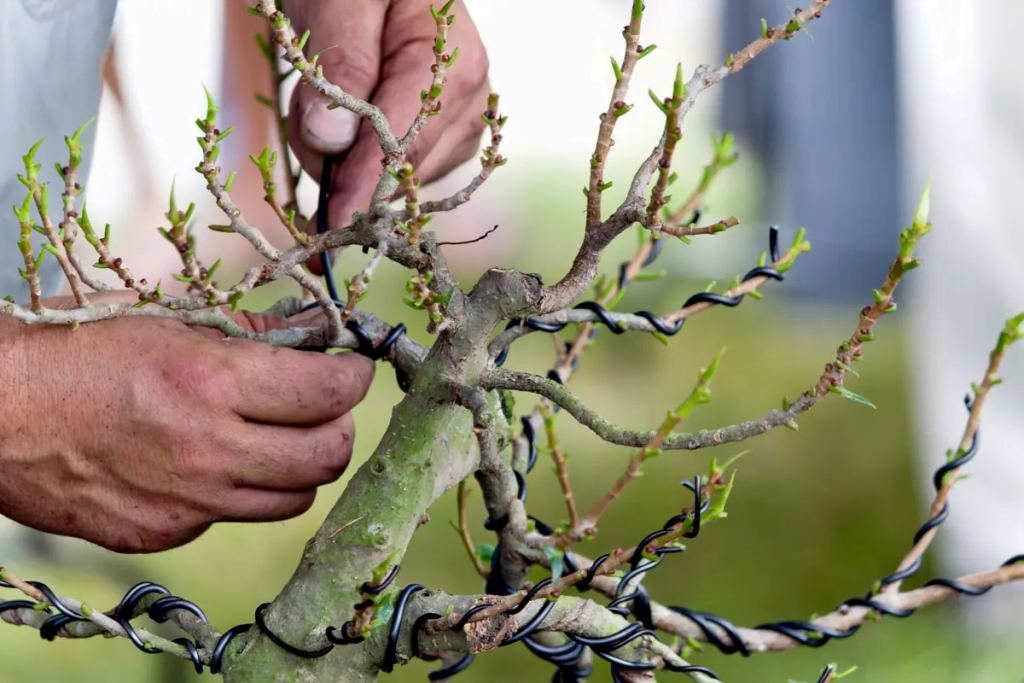
How to Remove the wire?
To quickly remove the bonsai wire, cut it into small sections, cutting in each wire turn. The wire cutters’ tips must be precisely aligned to release a piece of wire with each cut.
When using an aluminum wire, you can sometimes unwind it without cutting it piece by piece, but it is best to cut it if the wire has been embedded.
There are two sorts of wire cutters: one that is longer and more powerful and one that is slightly shorter. You should use a small bonsai wire cutter with little trees with thin branches. A large wire cutter, capable of cutting even the thickest bonsai wire, is required while working with medium or large wire bonsai tree.
Conclusion
Have you tried wiring your Bonsai before? To form your Bonsai tree, you’ll need to use bonsai wire. It is time-consuming and challenging, but it is worthwhile in the end. You will learn how to wire and will be pleased with the outcomes of your efforts.
First and foremost, you must establish your objectives. Choose the best season for your wire bonsai tree based on its requirements. Additionally, select the appropriate bonsai wire for your tree and begin wiring. Simply follow our step-by-step instructions and keep an eye out for any cuts or scars on the wires.
Once you’ve achieved the desired look for your wire bonsai tree, carefully remove the wires during the appropriate season. We hope that this post has given you a better knowledge of the bonsai wire process and inspired you to try it if you haven’t already.
Related Articles
- 15 Best Indoor Bonsai Trees for Beginners
- 15 Snake Plant Benefits | Reasons To Put A Snake Plant In Your Bedroom and Home
- 15 Stunning Flowering Bonsai Trees
- 20+ Best Indoor Plants for Bedroom that Help you to Give the Best Sleep Ever
- 20+ Best Indoor Plants for Kitchen
- 20+ Best Low-Maintenance Indoor Plants

